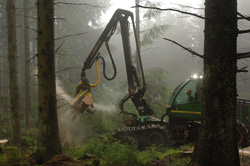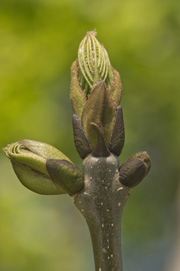Summary
Summary
 The forestry sector today is under increasing pressure to adapt to expanding demand for timber and woodfuel, the impacts of climate change, the conservation requirements for woodland ecosystems and the need to reduce management costs. It’s important that foresters incorporate the range of environmental concerns into their management plans
The forestry sector today is under increasing pressure to adapt to expanding demand for timber and woodfuel, the impacts of climate change, the conservation requirements for woodland ecosystems and the need to reduce management costs. It’s important that foresters incorporate the range of environmental concerns into their management plans
To ensure that forests are sustainable into the future woodland managers need to consider tree species selection, adapting planting regimes and technical innovations.
About the project
This two-year project is a partnership between research organisations and local authorities in northern France and southern England under the Interreg IVA France (Channel) England Cross-border Cooperation Programme 2007-2015. Such cross-border collaborations integrate a broad knowledge base and expertise to facilitate forest adaptation and improve resilience.
Research objectives
The overall aim of the project is to stimulate a cross-border strategy for understanding the climate change responses and adaptation capacity of forest ecosystems commonly found in the south of England and north of France.
This strategy was initiated through the previous cross-border project MULTIFOR. AdaFor provides an opportunity to develop and broaden the work with the following specific objectives:
- To improve our knowledge and understanding of the impact of climate change by monitoring differences in the phenological (life-cycle timing), biodiversity, dendrology and health of forests on both sides of the Channel
- To increase awareness amongst foresters and woodland owners on the potential impacts of climate change and to develop innovative management solutions within a framework of sustainability
- To improve the quantity and quality of forest management to increase woodfuel production and renew/enhance ecosystem services
The associated activities will be undertaken jointly through networks on either side of the Channel.
Forest Research involvement
Forest Research’s principal contributions to the project are:
- To assess the influence of climate change on forests and provide advice on appropriate management practices
- To investigate ecosystem services provided by woodland and establish methods to enhance these services through management
How are we achieving this?
To find out what activities we’re involved in see Achieving our objectives.
Funders and partners
The ADAFOR project is part funded by the European Union (European Regional Development Fund ERDF) within the framework of the European INTERREG IVA France (Channel) England Cross-border Cooperation Programme 2007-2015, under the priority to: ‘Ensure a sustainable environmental development of the common space’; with the objective to ‘Ensure a balanced management of the environment and raise awareness about environmental issues’.
The Forest Research component is being provided with match funding from the Forestry Commission.

![]()

Status
2013 to 2015.
Contact
Achieving our objectives
To contribute to the objectives of the AdaFor project, Forest Research undertook the following activities:
1- DNA Metabarcoding – exploring its potential as a rapid and accurate forest biodiversity assessment tool
Our ability to detect and describe changes (including declines) in species diversity are severely limited by cost and time. We are trialling the use of the genetic DNA metabarcoding technique as a rapid and accurate forest biodiversity assessment tool to help rapidly, accurately and inexpensively detect and define critical ecological thresholds for forest biodiversity.
For almost all animal groups, a 648 base-pair region within the mitochondrial gene cytochrome c oxidase 1 works as a barcode for species discrimination. By sequencing this short, standardized gene region, DNA metabarcoding permits the identification of all species collected in a single sample.
DNA metabarcoding techniques have been used to identify ground-dwelling arthropods of the forest floor which were collected by pitfall trapping along a gradient of beech forest decline in the New Forest, Hampshire in southern England. Stands sampled ranged from intact densely shaded stands to open stands with limited canopy cover where the beech woodland is in a collapsed state.
Comparisons of samples identified morphologically and using metabarcoding techniques, revealed a very similar number of species returned with identical, or closely related species identities. The relative sizes of specimens also did not appear to affect the overall resulting species that were identified. These are promising results regarding the future application of metabarcoding as a biodiversity monitoring tool.
130 species were recovered in total. Taxonomic groups that were represented included, in order of species richness, Diptera (flies), Coleoptera (beetles), spiders, springtails, woodlice, ants, millipedes, moths, slugs, earthworms, wood cricket, barkfly, ichneumon wasps, bumble bees, lacewings and harvestmen. The loss in beech habitat cover through progressive beech dieback had the effect of increasing overall species richness. This is likely to be the result of the development of a ground vegetation layer which is otherwise typically suppressed under beech.
Reference: Barsoum, N. A’Hara, S., Cottrell, J., Evans, P., Fuller, L. and Yu, D. (2015) Exploring the use of metabarcoding as a biomonitoring tool to detect critical thresholds of habitat cover for woodland-dependent arthropods along a gradient of beech forest dieback. Report to the FC and EU pp.28.
2-Tree phenology monitoring and assessment
 A study of the timing of oak bud burst in spring and leaf colouring in autumn was undertaken from 2011-14 across five forested regions in southern England (Norfolk, Hampshire, Devon and Cornwall) and northern France (Nord-Pas de Calais and Picardie).
A study of the timing of oak bud burst in spring and leaf colouring in autumn was undertaken from 2011-14 across five forested regions in southern England (Norfolk, Hampshire, Devon and Cornwall) and northern France (Nord-Pas de Calais and Picardie).
By monitoring the leaf budburst of oak in the spring and the senescence of those leaves in the autumn, this study has demonstrated that there can be substantial variation in these events from one year to the next, and between regions. Across the distance from the Peninsula region to Picardie, certain years showed similarities in the responses of the oaks, most likely due to greater coherence in climatic conditions in that year across the whole study area. However, some stands within a region show dates for spring and autumn that are consistently different to those of neighbouring stands. Such variation suggests that oak phenology studies should consider using large numbers of trees (e.g. ≥15 trees) within a defined and limited area. A large sample, larger than used in this study, would allow the within-stand variation to be better understood and the relative proportions of signal to noise in the data to be maximised. When stands are grouped into regions for comparison, it appears that 8 stands per region give a reasonable level of replication. It is also important that such phonological surveys are repeated for many years, to try to ensure that anomalous years’ phenology do not unduly influence the detection of any overlying trends.
Reference : Eaton, E., Barsoum, N., Bonnart, X., Havet, N. and Morison, J. (2015) Oak phenology in southern England and northern France. Report to the FC and EU pp.19
3 –Provenance trials – Hucking Estate, Kent
In 2011, a two-hectare plot was planted in with trees from the local area and some from Northern France and Central Italy. These European regions were selected using climate matching models which identified Northern France and Central Italy as having a climate today that Kent is likely to experience in 2050 and 2080 respectively.
Three native tree species (Oak, Ash and Wild Cherry) and one naturalised species (Sweet Chestnut) have been used for the experiment. Planting the trees together in one location allows us to assess if trees from different provenances display different responses and suitability to climatic conditions.
The trees have been planted in various configurations to test the effect of single species/provenance planting with mixed species/provenance planting. (For example; a tree from one provenance developing leaves early in the season may outcompete a neighbour with later developing leaves.)
The value of the climate-match provenance trials is expected to increase over time. Differences between local and climate-matched provenances in traits such as survival, growth and even shoot dieback are limited so far, but are expected to become more apparent with time. Although the canopy sizes of saplings are currently small, we are nevertheless starting to see some significant planting ratio effects on levels of insect herbivory which provides early evidence that mixed provenance and mixed species stands can confer greater resilience to insect pests compared with monocultures.
The climate-match provenance trials described here are one of many similar trials that are emerging world-wide that seek to facilitate tree species choice and provide advice on planting designs to optimise the adaptive capacity of trees and forests to climate change.
References : Barsoum, N. (2015) Mixed provenance and mixed species trials aimed at informing the debate on how to prepare native tree species for climate change in England. Quarterly Journal of Forestry (in press)
4- Demonstration of a rapid biodiversity assessment methodology to facilitate balanced forest management of multiple ecosystem services
A survey methodology (i.e. the Rapid Woodland Biodiversity Assessment – RWBA) was developed that allows for a rapid assessment of the current potential of a woodland, or given Forest Management Unit, to provide habitat for biodiversity. A range of biodiversity indicators were used to gauge potential levels of biodiversity. These biodiversity indicators are rapid and inexpensive to assess and do not require any specific expertise beyond the ability to identify native and non-native tree and shrub species. Since actual biodiversity is not measured, the assessment describes ‘potential’ rather than ‘actual’ levels of biodiversity. The RWBA feeds back to the forest manager specific management steps that could be taken to further enhance biodiversity. Two case study woodlands with contrasting levels of management intervention and tree species composition were assessed using the RWBA methodology to demonstrate how biodiversity information is collected and interpreted. Furthermore, this study demonstrated how specific changes in management for improved biodiversity provision impacts on the delivery of other ecosystem service’s such as timber or woodfuel production and carbon sequestration in the two case study woodlands.
References: Barsoum, N., Henderson, L., Mackie, E., Morison, J. and Randle, T. (2015) Demonstrating a rapid biodiversity assessment methodology to facilitate the management of multiple forest ecosystem services (PDF-1132 KB). Report to the FC and EU pp.94.
5- Barriers and incentives to multifunctional woodland management.
Through the use of questionnaires and telephone surveys, this work explored what woodland professionals perceived to be the main barriers to multifunctional management and what sorts of incentives were required to inspire action. The role of public access in preventing active woodland management was also explored.
Reference: Pitcher, P. (2014) Woodland Management: Focussing on evaluating the effects of barriers/incentives on multifunctional woodland management in the UK under the ADAFOR project. MSc dissertation, Environmental Management The University of Reading Department of Geography & Environmental Science pp. 62.
6- Dissemination of information and research results to the forestry sector
FR participated in the UK Forestry Society and Woodland Management Workshop (27 February 2014) organised by the Institute of Chartered Foresters and Forestry Commission England. A questionnaire was circulated to forest managers to gain a better understanding of management decisions around multiple forest ecosystems. FR also participated in an end of project conference held at Penstock Barn, East Brabourne, Kent (March 5-6, 2015), with the goal of providing guidance for forest apprentices and existing managers on topics such as future forest threats and ecosystem service approaches.
References: Barsoum, N., McCartan, S., Wilkinson, M., Morison, J., Cottrell, J., Hubert, J. and Ray, D. (2015) Increasing the adaptation potential of native tree species to global change. Poster presented at end of ADAFOR project conference held at Penstock Barn, East Brabourne, Kent (March 5-6, 2015),
